The meaning of movement is both
cultural and personal. Where we come from and what we believe will explain much
of how we react to human bodies moving.
photo - Nicole Rivelli
Here are some questions to consider how we look at, participate in, and interpret movement from a culturally biased perspective.
Here are some questions to consider how we look at, participate in, and interpret movement from a culturally biased perspective.
Where
did it come from?
What part of the world and what social group of people?
Who participates in it?
What part of the world and what social group of people?
Who participates in it?
Who
is empowered by it?
Who
is disempowered or threatened by it?
Does
it emphasize fluidity or rigidity?
Is
it inclusive or exclusive?
How
do we perceive the participants?
Is
it from a marginalized community? Like strippers, POCs, or immigrants?
What
are the benefits?
Does
this movement build community?
Have
perceived health benefits?
Does
it feel good or make us feel uncomfortable(to do or to watch)?
How
do we look at it? Where are we seeing it? On stage? In the streets? In a studio? At a half-time
show?
What
stories does it tell?
What are our judgments based on?
Answer the above questions for some of
these dance styles and you will learn a lot about yourself and the world we
live in…
Salsa
Belly
dancing
Pole
dance
Hip
Hop
Capoeira
Tap
Jazz
Modern
Post
Modern
Ballet
Swing
Dance
Hustle
Contemporary
Lyrical

No comments:
Post a Comment